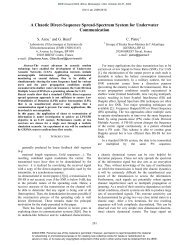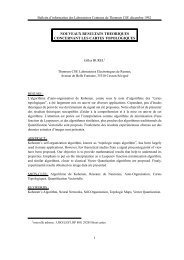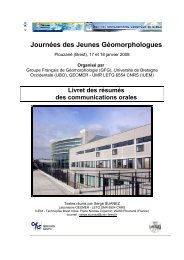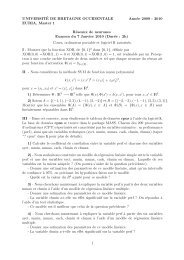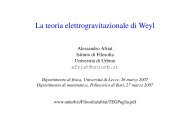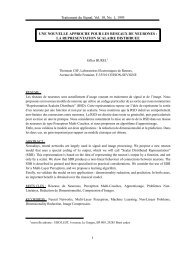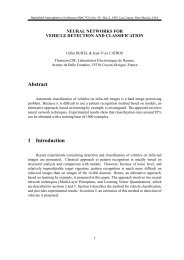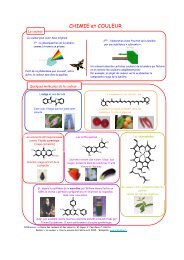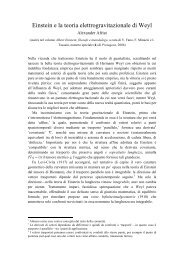Duhem, Quine and the other dogma
Duhem, Quine and the other dogma
Duhem, Quine and the other dogma
- No tags were found...
Create successful ePaper yourself
Turn your PDF publications into a flip-book with our unique Google optimized e-Paper software.
<strong>Duhem</strong>, <strong>Quine</strong> <strong>and</strong> <strong>the</strong> o<strong>the</strong>r <strong>dogma</strong> 3<br />
A given meaning, <strong>the</strong>n, breaks an object up into essential <strong>and</strong> accidental features,<br />
<strong>the</strong> latter being unintended <strong>and</strong> dispensable, in <strong>the</strong> sense that without <strong>the</strong>m<br />
<strong>the</strong> object would remain ‘what it is’ <strong>and</strong> not be ontologically compromised. The<br />
idea is that since a man after a haircut undoubtedly remains a man, what’s left on<br />
<strong>the</strong> barber’s floor was accidental.<br />
Suppose a word W refers to an object O characterised by certain features F =<br />
{F 1 , F 2 , . . .}. Whereas reference catches all <strong>the</strong> features, essential <strong>and</strong> accidental,<br />
only <strong>the</strong> essential ones ¯F are meant by W . Even if we know that ¯F is a proper<br />
subset of F , it may be less clear exactly which elements make it up. Hence <strong>the</strong><br />
following test: remove <strong>the</strong> features one by one, <strong>and</strong> see what happens; if F 1 is<br />
removed <strong>and</strong> <strong>the</strong> object with features {F 2 , F 3 , . . .} is still intended, F 1 was not<br />
essential, <strong>and</strong> so on. Of course <strong>the</strong> test cannot be conclusive since <strong>the</strong> essences ¯F<br />
are never found on <strong>the</strong>ir own, without accidents, some of which will necessarily<br />
be tangled up with essences (which could o<strong>the</strong>rwise exhaust <strong>the</strong> object). Suppose<br />
a physical constraint prevents F m from being separated from F n . We notice that<br />
W still applies when both are present, <strong>and</strong> that it no longer does once <strong>the</strong>y have<br />
been removed. What <strong>the</strong>n We cannot tell <strong>the</strong> three cases (1. F m ∈ ¯F , F n /∈ ¯F ;<br />
2. F m /∈ ¯F , F n ∈ ¯F ; 3. F m ∈ ¯F , F n ∈ ¯F ) apart <strong>and</strong> must <strong>the</strong>refore wonder about<br />
dispensability; for if a feature F m cannot be removed without taking something<br />
essential with it, in what sense was that feature dispensable <strong>and</strong> hence accidental<br />
F m <strong>and</strong> F n may be conceptually separable, just by thought, but physical separation<br />
can be considered more trustworthy <strong>and</strong> ‘empirical.’ This entanglement of essence<br />
<strong>and</strong> accident already adumbrates <strong>the</strong> holisms of <strong>Duhem</strong> <strong>and</strong> <strong>Quine</strong>.<br />
For proper names <strong>and</strong> single objects <strong>the</strong> problem is insurmountable. But even if<br />
<strong>the</strong> essential features ¯F cannot exist on <strong>the</strong>ir own, without accidental ones of some<br />
kind or o<strong>the</strong>r, <strong>the</strong>y may be found with different sets of accidental features: W<br />
could refer to various objects (which perhaps constitute a ‘natural kind’). In o<strong>the</strong>r<br />
words ¯F may be accompanied by <strong>the</strong> accidents {F 1 1 , F 1 2 , . . .} or by {F 2 1 , F 2 2 , . . .}<br />
or {F 3 1 , F 3 2 , . . .} etc., in which case W , while meaning ¯F , would refer to object<br />
O 1 with features F 1 = { ¯F , F 1 1 , F 1 2 , . . .} or to object O 2 with features F 1 =<br />
{ ¯F , F 2 1 , F 2 2 , . . .} <strong>and</strong> so on. Even without knowing <strong>the</strong> exact makeup of ¯F beforeh<strong>and</strong>,<br />
it is clearly a subset of ˆF = ⋂ F i ; <strong>and</strong> if <strong>the</strong> family of objects O 1 , O 2 , . . .<br />
is sufficiently large <strong>and</strong> <strong>the</strong> accidental features sufficiently varied, one can reasonably<br />
identify ¯F with ˆF . The extension of W , if large <strong>and</strong> varied enough, <strong>the</strong>refore<br />
allows us to determine <strong>the</strong> intended essence. The idea being that even if that<br />
essence cannot be physically abstracted from <strong>the</strong> bearing object, with all its accidents,<br />
it can be abstracted from particular accidents (ra<strong>the</strong>r than o<strong>the</strong>rs); for <strong>the</strong><br />
distinguished features ¯F emerge as <strong>the</strong> ones belonging to all <strong>the</strong> objects.<br />
But of course not all linguistic forms are words. <strong>Quine</strong> seems to have been<br />
chiefly concerned with sentences, to whose meaning <strong>and</strong> reference we now turn.



